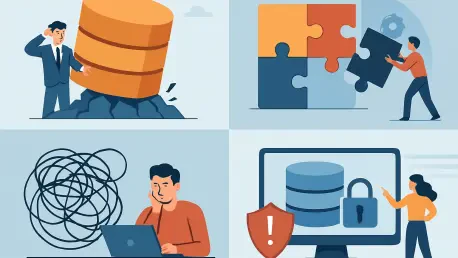What happens when the backbone of a company’s success becomes its biggest obstacle? Across industries, legacy databases—repositories of decades of critical business intelligence—are turning into silent liabilities, unable to keep pace with the demands of a hyper-digital era. These systems, once the foundation of operational excellence, now struggle with scalability, security, and integration, putting enterprises at risk of falling behind. Yet, the thought of modernization stirs unease: how can vital historical data, the very DNA of business decisions, be preserved during such a seismic shift? This feature delves into the high-stakes journey of updating outdated IT infrastructure while protecting invaluable insights, uncovering strategies that balance innovation with continuity.
Why Modernization Is Non-Negotiable
The urgency to modernize isn’t a mere trend—it’s a survival imperative. Legacy systems, often built decades ago, falter under the weight of today’s data volumes and real-time processing needs. A recent industry survey revealed that 68% of IT leaders cite outdated infrastructure as the primary barrier to adopting transformative technologies like artificial intelligence or cloud computing. Beyond technical limitations, these aging platforms drain resources, with maintenance costs consuming up to 60% of IT budgets in some organizations. The message is clear: sticking to the old ways hampers growth and agility in a market that waits for no one.
Security adds another layer of concern. Older databases frequently lack modern encryption or compliance features, making them prime targets for cyberattacks. The financial and reputational damage from a single breach can be catastrophic, especially when sensitive customer data or proprietary insights are exposed. For business leaders, the question isn’t whether to modernize but how to do so without disrupting operations or losing the institutional knowledge that defines their competitive edge. This challenge sets the stage for a deeper exploration of risks and rewards.
The Hidden Costs of Clinging to Legacy Systems
Beyond the surface-level inefficiencies, legacy systems impose a stealth tax on innovation. Their inability to integrate with cutting-edge tools creates silos, where data remains trapped and inaccessible to modern analytics platforms. This isolation stifles initiatives like predictive modeling or customer personalization, which rely on seamless data flow. For a mid-sized logistics firm, this meant missing out on real-time route optimization, costing millions in delayed deliveries over a single year. Such examples highlight how outdated infrastructure directly impacts the bottom line.
Moreover, the talent drain is an often-overlooked consequence. Younger IT professionals, accustomed to agile, cloud-native environments, find legacy systems cumbersome and unappealing. High turnover rates in tech teams exacerbate the problem, leaving companies scrambling to maintain systems few understand. The cumulative effect is a business stuck in a technological quagmire, unable to pivot or scale when market dynamics shift. Addressing these hidden costs requires more than patchwork fixes—it demands a strategic overhaul.
Tackling the Modernization Challenge
Navigating the path to modern infrastructure is akin to performing surgery on a living organism: precision is paramount. One major hurdle is compatibility, as legacy systems often resist integration with newer platforms due to outdated code or proprietary formats. A practical solution lies in phased migrations, where data and applications are moved incrementally, reducing the risk of catastrophic failure. This approach allowed a regional bank to transition to a cloud-based system over six months, avoiding downtime while updating critical services.
Preserving business intelligence during this process remains a top priority. Historical data isn’t just numbers—it’s the story of a company’s evolution, capturing patterns and decisions that shape strategy. Robust backup protocols and data mapping ensure nothing is lost in translation. Additionally, hybrid models, blending old and new systems, offer a middle ground for organizations wary of full-scale replacement. These strategies underscore that modernization isn’t about erasure but about building on a foundation of past success.
Another key aspect is managing stakeholder expectations. Employees accustomed to familiar systems may resist change, fearing disruption or retraining. Transparent communication, paired with hands-on support, can turn skeptics into advocates. A manufacturing giant achieved this by involving staff in pilot testing, smoothing the transition to a new database platform. Such steps demonstrate that modernization is as much about people as it is about technology, requiring a holistic view of organizational needs.
Expert Voices on Bridging Past and Present
Insights from the field add depth to the modernization puzzle. A veteran IT consultant with over 20 years of experience shared, “Companies often underestimate the narrative locked in their legacy data—it’s not just records; it’s their roadmap to past wins and losses.” This perspective emphasizes why preserving business intelligence isn’t optional but a strategic necessity. Experts advocate for meticulous planning, warning that rushed migrations often lead to costly errors like data corruption or prolonged outages.
Real-world experiences reinforce this caution. A healthcare provider faced weeks of downtime after a poorly executed migration, disrupting patient care and eroding trust. In contrast, firms that partnered with specialized integration teams reported smoother transitions, with 75% of successful projects involving external expertise, per a recent tech report. These stories highlight a critical lesson: professional guidance can mean the difference between a seamless upgrade and a business setback. Hearing from those who’ve navigated this terrain offers a grounded view of what works and what doesn’t.
A Blueprint for Seamless Transition
Charting a course for modernization requires a clear, actionable framework. The first step is a comprehensive audit of existing systems to pinpoint critical data sets and vulnerabilities. This assessment lays the groundwork for prioritizing what to migrate and when. For instance, a retail chain identified customer transaction records as its most vital asset, ensuring their transfer was the first phase of a broader overhaul. Such precision minimizes risk and aligns upgrades with business goals.
Partnering with migration specialists is another cornerstone of success. These professionals bring structured methodologies—spanning planning, execution, and validation—to the table, safeguarding data integrity at every turn. Custom solutions, like tailored APIs, enable legacy and modern systems to coexist, ensuring historical insights remain accessible. Testing is equally vital, with phased rollouts allowing for adjustments before full deployment. This methodical approach transforms a daunting task into a manageable progression.
The long-term payoff of modernization extends beyond fixing immediate issues. Scalable infrastructure equips businesses to handle demand surges, while reduced technical debt frees up budgets for innovation. Enabling advanced analytics or AI-driven tools opens doors to new opportunities, from personalized marketing to operational efficiencies. A tech startup, post-migration, leveraged real-time data to cut product launch times by 30%, illustrating the competitive edge modern systems confer. This blueprint empowers organizations to evolve without losing their roots.
Reflecting on the Path Forward
Looking back, the journey of database modernization revealed a profound truth: progress and preservation are not mutually exclusive. Enterprises that embraced strategic upgrades while safeguarding their business intelligence found themselves better positioned to navigate market challenges. The stories of those who stumbled due to inadequate planning served as stark reminders of the stakes involved, yet they also illuminated the power of expert collaboration in overcoming obstacles.
As businesses move forward, the next steps involve committing to thorough assessments of current systems and seeking partnerships with seasoned migration teams. Exploring hybrid models can offer a balanced transition, ensuring no critical data falls through the cracks. Above all, viewing modernization as an investment in resilience—rather than a mere expense—shifts the mindset toward long-term value. The road ahead promises agility and innovation for those ready to adapt, proving that the heart of business intelligence can beat stronger in a modern era.









